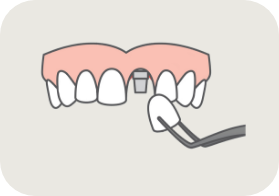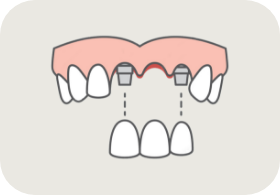Implant Supported Dental Bridges
Home / Dental Implants / Implant Supported Dental Bridges
Implant Supported Dental Bridges
Are you missing several teeth, but not enough to require replacement of the entire arch? Implant supported dental bridges can provide an attractive, functional, long-term solution. Unlike fixed bridges or removable partials, an implant supported bridge won’t require support from your healthy surrounding teeth. This is different from conventional bridges. In a conventional bridge, existing teeth are compromised. These end teeth are used to support the two ends of the bridge.
Implant supported bridges preserve your chewing ability. They help to maintain the attractiveness of your smile. Dental implant supported bridges also assist in preserving the integrity of your jaw bone at the location of the implants.


What are the benefits of implant-supported tooth bridges?
There are several advantages of choosing an implant-supported restoration. The most notable benefit is that the natural teeth do not need to be reduced. Therefore, your healthy tooth structure can be left intact. Another advantage is that implants replace the missing teeth roots. This is beneficial because they stimulate the jawbone and prevent bone degeneration.
How Do Implant Supported Dental Bridges Work?
Traditional and implant-supported bridges both replace two or more missing teeth in a row. Traditional bridges are often held in place by neighboring teeth that are capped with a dental crown.
Implant-supported bridges are anchored to the jawbone with a single dental implant or multiple implants, depending on the number of missing teeth. Dental implants are titanium posts that replace missing roots. Because the implants integrate with the jawbone, the prosthetic is able to feel and function like natural teeth.
The dental implants are placed in the jaw, creating solid anchors over time as the bone and titanium (typically) integrate. A bridge of teeth is created to match the shading, shape and size of your existing teeth. This bridge will then be affixed to the implants. This procedure will allow you to enjoy a healthy new smile and renewed confidence in only a day.
Following your initial procedure, you will be seen for routine checkups to assess the integration of your implants. This is to ensure that the implant and surrounding bone have integrated successfully.


Implant Supported Dental Bridges
Are you missing several teeth, but not enough to require replacement of the entire arch? Implant supported dental bridges can provide an attractive, functional, long-term solution. Unlike fixed bridges or removable partials, an implant supported bridge won’t require support from your healthy surrounding teeth. This is different from conventional bridges. In a conventional bridge, existing teeth are compromised. These end teeth are used to support the two ends of the bridge.
Implant supported bridges preserve your chewing ability. They help to maintain the attractiveness of your smile. Dental implant supported bridges also assist in preserving the integrity of your jaw bone at the location of the implants.

What are the benefits of implant-supported tooth bridges?
There are several advantages of choosing an implant-supported restoration. The most notable benefit is that the natural teeth do not need to be reduced. Therefore, your healthy tooth structure can be left intact. Another advantage is that implants replace the missing teeth roots. This is beneficial because they stimulate the jawbone and prevent bone degeneration.
How Do Implant Supported Dental Bridges Work?
Traditional and implant-supported bridges both replace two or more missing teeth in a row. Traditional bridges are often held in place by neighboring teeth that are capped with a dental crown.
Implant-supported bridges are anchored to the jawbone with a single dental implant or multiple implants, depending on the number of missing teeth. Dental implants are titanium posts that replace missing roots. Because the implants integrate with the jawbone, the prosthetic is able to feel and function like natural teeth.
The dental implants are placed in the jaw, creating solid anchors over time as the bone and titanium (typically) integrate. A bridge of teeth is created to match the shading, shape and size of your existing teeth. This bridge will then be affixed to the implants. This procedure will allow you to enjoy a healthy new smile and renewed confidence in only a day.
Following your initial procedure, you will be seen for routine checkups to assess the integration of your implants. This is to ensure that the implant and surrounding bone have integrated successfully.

Our Dental Implant Process
WHAT IS THE PROCESS OF OUR DENTAL SOLUTION?
01
Consultation
& Planning
Before the procedure, Dr. Rattan will use advanced technology including CT scans, 3D facial scanners, intra-oral cameras to plan the ideal treatment for patients. Dr. Rattan will also discuss your medical history, current medications, and any current health problems to determine if you are an ideal candidate for oral surgery.
02
Treatment
Plan
Dr. Rattan will present you with your treatment plan and discuss financing options. If you decide to proceed with treatment, your implant placement procedure will be scheduled for a later date. In some cases, a pre-op appointment may also be scheduled to discuss dental sedation, how to prepare, and to go over any prescriptions needed.
03
Surgery &
Placement
The day of your appointment, Dr. Rattan will begin with extraction of any remaining teeth and perform surgical treatment for the placement of dental implants. Four dental implants will be placed in the upper arch and an additional four implants will be placed in the lower arch. These implants will be used to support a temporary denture while the implant sites heal.
04
Recovery &
Final Restoration
The recovery time is approximately three months. Our caring dentists will explain to you everything about oral care during your recovery period. In the final step, the temporary acrylic teeth are replaced with permanent teeth that are made of sturdy materials.
Frequently Asked Questions
An implant-supported bridge can help you restore the appearance and functionality of your smile. We would recommend this procedure for patients with bite issues that result from missing teeth causing the remaining teeth to shift out of their correct position. Patients who don’t have adequate jawbone support for dental implants may also benefit from an implant-supported bridge. If you grind or clench your teeth, an implant-supported bridge will spread the pressure evenly across the entire bridge.
An implant-supported bridge is considered less invasive than other options, as it doesn’t require us to alter the structure of any adjoining natural teeth or their enamel. You’ll be able to chew and speak normally while improving the appearance of your smile and your oral health. Because dental implants replace your natural tooth roots, they stimulate bone growth and prevent future bone loss. You also won’t have to worry about dental crowns becoming worn or your adjacent teeth loosening over time. Many patients prefer the look and feel of an implant-supported bridge over a removable partial denture because it feels more comfortable and secure.
If your missing teeth are adjacent and you have enough healthy jawbone to support dental implants, you may be an ideal candidate for an implant bridge. For the best results, you should have any gum disease or tooth decay issues treated first. It’s also recommended that you quit smoking and commit yourself to keeping up with proper oral hygiene to remain in good oral health during recovery and after.
Traditional dental bridges usually need a replacement every 5-15 years, depending on the level of patient care. However, a tooth-supported fixed bridge can last up to two decades or even longer.

- 2955 Corral Hollow Rd #100, Tracy, CA 95376, United States
- office@innovodentalstudio.com
Get Started
- Monday | 10 AM - 7 PM
- Tuesday | 9 AM - 6 PM
- Wednesday | 10 AM - 7 PM
- Thursday | 9 AM - 6 PM
- Thursday | 9 AM - 6 PM
- Friday | 10 AM - 7 PM

